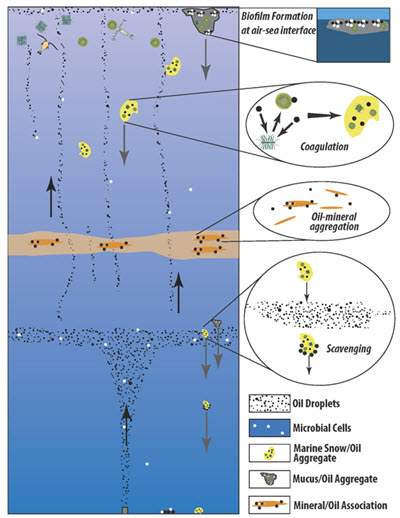
A photograph of oil-marine snow aggregates at the water’s surface in the Gulf of Mexico, May 2011. (Photo by Andrew Warren)
Evidence suggests that when oil interacts with particles in the marine environment, it can form larger, rapidly sinking particles called marine snow.
These oily aggregates are often transported from the sea surface to the seafloor. The snow falls more like a heavy blizzard than a light flurry for large discharges such as the Deepwater Horizon spill and could present a pathway for oil to enter the food web as it descends. Recent research indicates that oil transported to the seafloor is an important piece in calculating the oil budget. However, oil transported via marine snow is rarely incorporated into oil transport models, which focus on the distribution of oil by currents.
The Gulf of Mexico Research Initiative recently awarded Dr. Adrian Burd a grant to develop a model with parameters that can predict how oil will interact with other particles present in the marine environment. Burd’s team will then use this model to investigate how these interactions affect oil sedimentation to the deep ocean. Burd explained, “It is important to understand the mechanisms behind oil-particle interactions and processes because, although these aggregates remove oil from surface waters, they also cause oil to be deposited on the ocean floor.”
 The schematic (at right) depicts the interactions between oil, mineral particles, and marine snow in the water column. Oil droplets in the water column can create aggregates with mineral particles and marine snow. These large particles rapidly sink through the water column carrying the oil with them, creating a process that transports oil from the surface to the deep ocean. Sinking particles that pass through sub-surface oil layers can accumulate and carry even more oil to the ocean floor. Meanwhile, oil that reaches the surface can form large mucus-oil aggregates which can also subsequently sink to the ocean floor. (Figure by Adrian Burd).
The schematic (at right) depicts the interactions between oil, mineral particles, and marine snow in the water column. Oil droplets in the water column can create aggregates with mineral particles and marine snow. These large particles rapidly sink through the water column carrying the oil with them, creating a process that transports oil from the surface to the deep ocean. Sinking particles that pass through sub-surface oil layers can accumulate and carry even more oil to the ocean floor. Meanwhile, oil that reaches the surface can form large mucus-oil aggregates which can also subsequently sink to the ocean floor. (Figure by Adrian Burd).
The researchers plan to incorporate oil droplets, mineral particles, microbial mucus flocs, and the relevant processes affecting them (such as weathering and microbial production) into an existing coagulation model. First, they will develop a surface model extending from the ocean surface to 140 meters depth and begin constructing parameters that will predict the microbial-mucus-oil aggregates’ sizes and the rates at which they form and sink through the water column. Then, they will extend the model through the whole water column and incorporate the effects of oil-particle interactions and oil sedimentation rates.
The full model will allow the team to predict how much oil is trapped in these sinking aggregates and how rapidly it settles under a wide range of conditions. Burd emphasized the utility of this model, “This information will be useful not only to understanding the fate of oil in water but also to first-responders, who will need to know how the oil is distributed in the water.”
This project’s researchers are Adrian Burd at the University of Georgia Department of Marine Science, Kendra Daly at the University of South Florida College of Marine Science, and Uta Passow at the University of California – Santa Barbara Marine Science Institute with outreach support from Liesl Hotaling at the University of South Florida College of Marine Science. Their project is Oil-Marine Snow-Mineral Aggregate Interactions and Sedimentation during the 2010 Deepwater Horizon Oil Spill.
************
The Gulf of Mexico Research Initiative (GoMRI) is a 10-year independent research program established to study the effect, and the potential associated impact, of hydrocarbon releases on the environment and public health, as well as to develop improved spill mitigation, oil detection, characterization and remediation technologies. An independent and academic 20-member Research Board makes the funding and research direction decisions to ensure the intellectual quality, effectiveness and academic independence of the GoMRI research. All research data, findings and publications will be made publicly available. The program was established through a $500 million financial commitment from BP. For more information, visit http://gulfresearchinitiative.org/.
